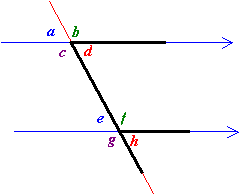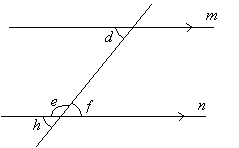Corresponding Angles Postulate And Its Converse
Related Pages
Alternate Interior Angles
Interior Angles of a Triangle
Geometry Help
In these lesson, we will learn the properties of corresponding angles formed by a transversal across two or more parallel lines.
In geometry, pairs of angles can relate to each other in several ways. Here we shall look at
- about Corresponding Angles
- the Corresponding Angles Postulate
- Converse of the Corresponding Angles Postulate
What Are Corresponding Angles?
A transversal is a straight line that crosses two or more straight lines. In this lesson, we will focus on transversals that cross two or more parallel lines.

When a line (called a transversal) intersects a pair of parallel lines, corresponding angles are formed. Corresponding angles are angles that are in the same relative position at an intersection of a transversal and at least two lines. If the two lines are parallel then the corresponding angles are congruent.
The following diagram shows examples of corresponding angles. Scroll down the page for more examples and solutions on using corresponding angles.

How to find corresponding angles?
One way to find the corresponding angles is to draw a letter F on the diagram. The letter F can also be facing the other way.
In the above diagram, d and h are corresponding angles.
The other corresponding pairs of angles in the above diagram are:
b and f;
cand g;
a and e.
(Corresponding angles found in a F-shaped figure)

Example:
In the following diagram, all the lines shown are straight lines. Line m is parallel to line n.
List a pair of corresponding angle.

Solution:
d and h are corresponding angles.
Alternate Angles, Corresponding Angles, Vertical Angles, Co-interior Angles
Alternate or Z angles, Corresponding or F angles, Vertical or X angles, Co-interior or C angles
What Is The Corresponding Angle Postulate?
The Corresponding Angle Postulate states that:
When a transversal intersects two parallel lines, the corresponding angles are equal.
A postulate does not need to be proved, but is assumed to be self-evident and true.
How To Find Corresponding Angles, Alternate Interior Angles & Alternate Exterior Angles?
How To Define Corresponding Angles And Their Properties?
Corresponding angles are angles that are in the same relative position at an intersection of a transversal and at least two lines. If the lines are parallel then the corresponding angles are congruent.
How To Find An Angle Using Corresponding Angles?
Corresponding angles are angles that are on the same side of the parallel lines, and on the same side of the transversal. A transversal is a line passes through the two parallel lines.
How To Use Corresponding Angles To Find The Values Of Different Angles?
Example:
In the diagram below, line s is parallel to line t, and line r is a transversal?
What is the measure of angle x?
What Is The Converse Of The Corresponding Angle Postulate?
The converse of the corresponding angle postulate states that:
If two lines and a transversal form corresponding angles that are congruent then the two lines are parallel.
How To Prove Lines Are Parallel?
We can use:
- Converse of the Corresponding Angles Postulate that states that “If two lines and a transversal form corresponding angles that are congruent, then the two lines are parallel."
- Converse of the Alternate Interior Angles Theorem that states that “If two lines and a transversal form alternate interior angles that are congruent, then the two lines are parallel."
- Converse of the Same-Side Interior Angles Theorem that states that “If two lines and a transversal form same-side interior angles that are supplementary, then the two lines are parallel."
- Converse of the Alternate Exterior Angles Theorem that states that “If two lines and a transversal form alternate exterior angles that are congruent, then the two lines are parallel."
- Converse of the Same-Side Exterior Angles Theorem that states that “If two lines and a transversal form same-side exterior angles that are congruent, then the two lines are parallel."
Examples:
- Which lines, if any, must be parallel if ∠3 and ∠2 are supplementary? Why?
- Find the value of x for which l ∥ m.
- A rectangular wooden frame has a diagonal metal brace. The angles indicated were measured to be equal. Which sides are parallel? Explain.
Proof By Contradiction That Corresponding Angle Equivalence Implies Parallel Lines
Try the free Mathway calculator and
problem solver below to practice various math topics. Try the given examples, or type in your own
problem and check your answer with the step-by-step explanations.

We welcome your feedback, comments and questions about this site or page. Please submit your feedback or enquiries via our Feedback page.